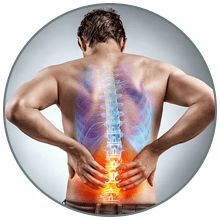Spinal Cord Stimulation
What is spinal cord stimulation?
Spinal cord stimulation or posterior medullary cord stimulation is a technique that has shown success in selected patients suffering from chronic pain. It is based on the principle that electrical impulses block the perception of pain, which is replaced by a tingling sensation in the painful region.
A small wire (an electrode) is implanted in the epidural space, and connected to a generator that is placed under the skin. The generator produces low-voltage electrical signals that are transmitted from the electrode to the spinal cord or specific nerves, thus preventing the painful signals from reaching the cerebral cortex. Using a remote control (a special knob) the patient can turn the electrical stimulation on and off and adjust the intensity.
Most patients describe the perceived sensations as a pleasant tingling sensation instead of pain in the affected body area.
Recently, another implantable modality has also become available: the High Frequency Spinal Neurostimulation System, which produces pain relief without paresthesia or cramping and is indicated as an adjunct in the treatment of chronic refractory pain of the trunk and extremities, including unilateral or bilateral pain.
How is it implanted?
Surgical implantation of the stimulator is performed in two phases:
- Test phase. It is used to test the stimulation system and check if it is effective in relieving pain and if it is satisfactory for the patient. It is performed under intravenous sedation and local anesthesia. With radiological image control, one or two electrodes are implanted inside the spine until they are left in the lumbar, dorsal or cervical epidural space (depending on the part of the body where the pain is located). The opposite end of the electrode is then brought to the outside and connected to an external stimulator device. For several weeks the patient will carry the external stimulator with him and will try different stimulation modalities, in order to assess whether his pain is relieved and whether the definitive implant is worthwhile.
- Definitive implant. It is performed in the same way under sedation and local anesthesia. An incision is made in the buttock, abdomen or chest area, depending on where the electrodes are located and where it is most comfortable for the patient, and a pulse generator (similar to a cardiac pacemaker) is inserted under the skin. The generator is connected to the electrodes in the vicinity of the medulla, passing them under the skin. From this moment on, the modifications to be made in the operation of the electrodes will be made by means of an external remote control, and can be carried out by the patient himself.
It is usual that during the first weeks it is necessary to make adjustments in the electrical parameters of stimulation, so that the pain relief is optimal.
Which patients can benefit?
Spinal cord stimulation has been shown to be effective in patients with the following conditions:
- Lumbar or cervical pain radiating to the extremities after failed surgery.
- Complex Regional Pain Syndrome (Reflex Sympathetic Dystrophy).
- Refractory anginal pain.
- Chronic pain due to ischemia of the lower extremities.
Despite promising results, spinal cord stimulation is not the first therapeutic option to be considered. It should be reserved for patients in whom all other pharmacological, rehabilitative and minimally invasive treatments have failed.
Lifestyle after implantation
- Do not drive or operate heavy machinery while the stimulator is running. You can ride as a passenger.
- Although the electrodes are fixed to the spine with a special system, however, they can be mobilized, which can happen, being necessary to reposition them. It is therefore necessary to take into account that the wearers of a stimulation system may not perform strenuous physical exercise or sports involving flexion and extension of the spine. It is also not recommended that they carry weights or exert themselves.
- With a spinal cord stimulator it is not recommended to perform radiofrequency procedures or magnetic resonance imaging.
- Spinal cord stimulators may set off metal detector alarms (as in airports). You will need to carry special identification at all times to certify that you have an implanted stimulation system.
- During the flight, staff may ask you to turn off the stimulator during takeoff and landing.
- Some stimulators may be sensitive to the anti-theft controls in some stores, and produce variations in stimulation while crossing. If in doubt, it is best to turn the stimulator off when passing through the controls.
- The stimulator control acts like a magnet, so it is advisable to keep it at least 5 cm away from magnetic strips such as credit cards and hard disks.

CONTACT
If you wish to contact us, to make an appointment or request more information about our services, please do so here
Patient Reviews
After months of intense pain in my back and leg due to a hernia, and after being full of medications and rehabilitation sessions, finally a friend recommended this clinic and I was absolutely right. They visited me very quickly and Dr Ruiz performed a radiofrequency intervention that has solved the problem, it no longer hurts and I have regained my quality of life, which I had lost. I only have words of gratitude
I had a rhizolysis two years ago and it is the best decision I ever made. I was advised to go to this clinic. Excellent staff and treatment. I would come back without hesitation. I am a different person since I don’t feel any pain.
In a frankly desperate situation with my mother suffering from trigeminal neuralgia and with continuous and terrible pain during confinement and no public health doctor able to relieve her pain in any way, it was miraculous to find this center by surfing the internet. In just a couple of weeks after the initial visit, Dr. Ruiz operated on my mother in an outpatient and non-aggressive surgery and in just a few days she regained speech, mobility and finally began to sleep as she no longer suffered the tremendous pain. And if the treatment has been effective thanks to the hands of a great doctor, this does not mean that the whole team at the center is not deserving of credit. From the reception to the nurses, they are all exemplary professionals who make you feel safe and in good hands at all times. My mother is already another and just 4 months later we are aware that there is no better investment than health and Clínica Vértebra is a success. Totally recommendable. THANKS A MILLION.
It has been a long time since I felt what it was like to live without pain. I only have words of gratitude for the whole team, from the reception staff to the operating room team. Thank you Dr. Squarcia for such a detailed explanation of my problem and for the accuracy of the treatment. I pray to God that this wellness lasts for a long time.
I had a lumbar facet denervation (Rhizolysis) this morning and I have to say that «O» pain. It has been 10 hours since the intervention and I am still without any pain and without medication. Congratulations to the whole team. Viggo Adeler (Physician)
Good treatment and attention, I went with a horse sciatica and they left me like new, I only have words of thanks.
It is a place that has improved my quality of life.
I only have words of thanks to Doctors Ricardo Ruiz and Dr. Matias, I have gone to them twice, and I only have words of thanks, they have solved my problem, first of Lumbar vertebrae and the second of a shoulder, and in both cases total success, I have not returned to have any kind of discomfort, I am totally grateful to them, they have changed my life. THANK YOU DOCTORS, you are fantastic.
First visit with Dr. Mattia Squarcia, finally a doctor who listens to me and looks at all my medical tests. I have already had a bad experience with another pain clinic where the doctor did not listen to me and did not even look at a single medical test.
I have only words of thanks, thank you Doctor Ricardo Ruiz.







